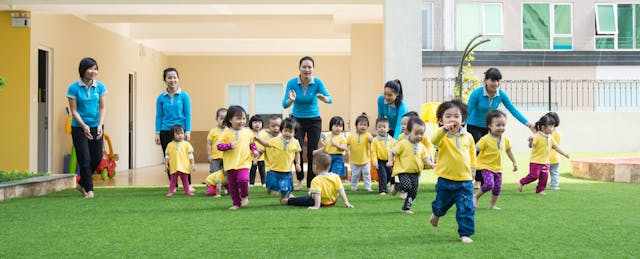The sun shone as we cruised over the bridge—new since my previous trip to Hanoi just two years ago—en route to the airport. Motorbikes, a staple in Vietnam’s city life, remained separate from the cars in a dedicated right lane. The scenery and contrast from my last time in Vietnam offered me a chance to reflect on the country’s bright future.
Development continues apace; in both Ho Chi Minh City and Hanoi, I marveled at how much the cityscapes have changed in less than two years.
And the education scene appeared brighter as well.
When I left Vietnam two years ago, the opportunities for innovation appeared bleak in many respects. Given that the government mandated not just the curriculum in schools—public as well as many private ones—but also the lockstep pace at which the lessons were delivered in an extraordinary compliance-driven way, the opportunities to introduce personalized learning were few. Little blended learning was taking place, and most instruction that I observed was not inspiring. And because the required national curriculum in Vietnam for secondary and high school was so broad—13 to 14 subjects—there was little ability for public schools to offer extracurricular classes that students might want to take in innovative ways.
The primary opportunities for change appeared in two areas: a few places of nonconsumption where disruptive innovations typically start because the alternative is quite literally nothing at all, and the few private schools that enjoyed some instructional freedom and might emerge as prominent proof points.
One primary area of nonconsumption was in the after-school market, where a few of the after schools I had visited on my trip appeared as though they might adopt blended learning.
On my return trip, one after school had moved definitively to adopt blended learning: Everest Education, a company that I advise. It recently closed a $1.4 million Series A funding round to fuel its growth and development of its blended-learning instructional models. This funding will allow the company to better educate its students and serve more of Vietnam’s—and ultimately the world’s—population faster, as its co-founder and CEO Tony Ngo has written. The team is building some of its own technology, working with third-party content providers, and continuing to evolve its blended-learning model as it tests different learning arrangements in different subjects.
In the blended classes I observed in Ho Chi Minh City, the station rotation model worked well as the students brought energy to their work and the teachers effectively managed the classroom and their small-group instruction. When the students switched stations, the rotations were crisp with little time wasted. The energy was palpable. With its programs in Vietnam and Los Angeles, Everest’s opportunity to scale its low-cost blended-learning model worldwide is intriguing. And if the school continues to deliver good outcomes for students, then I wouldn’t be surprised if more after-school programs popped up in the country to imitate Everest’s success.
On my last day in Vietnam, I keynoted an all-day conference on blended learning for Vietnamese educators that the Ministry of Education and Training and Olympia Schools hosted in Hanoi. There, I saw another opportunity for innovation materializing in a key proof point school for the country.
I had spent considerable time with Olympia Schools on my first trip to Vietnam as part of my Eisenhower Fellowship. I saw signs that it could become a model for blended learning in Vietnam in the near future, and this prediction appears to have come true. I was struck by the school’s commitment to blended learning and how the new instructional approach created time for students to apply their learning in a variety of creative and meaningful projects in the community. A video the school played at the conference begins to reveal the team’s dedication to blended learning for Vietnam.
I was also struck that the Ministry would hold a conference on blended learning alongside Olympia. In my previous visit, while many of the government officials I had met seemed interested in pushing teachers to innovate—hard to do given the aforementioned policy constraints—they didn’t seem interested in blended learning per se. But what a difference two years makes. For the Ministry to promote blended learning in concert with the country’s new national curriculum they are debuting—and for them to suggest at the conference that teachers may not need to teach in lock step—was a big step and may pave the way for bigger movement in the years ahead.
Although blended learning remains small in Vietnam, excitement is building. The development of a blended-learning after-school chain and a blended-learning elite private school that the Ministry is embracing should encourage more innovation. I predict we will see two more pockets of blended learning emerge in the next couple years. First, rural areas that cannot afford English teachers will embrace blended learning through mobile devices. And innovative education programs will pop up to serve ethnic populations in remote areas of Vietnam where students currently drop out of public schools as early as first grade.
I’m also sure there will be surprises along the way, but for now, the opportunities for innovation in education in Vietnam appear brighter along with the rest of the country’s fortunes.


